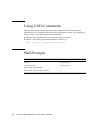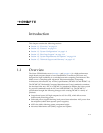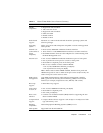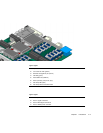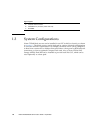
1-2 Netra CP3260 Blade Server User’s Guide • April 2009
■ Elimination of PCI connectivity between the blade servers in the system and
reallocation of connectivity to serial interconnects, eliminating single points of
failure
■ Mandatory use of Intelligent Platform Management Interface (IPMI) management
interfaces
■ Flexible user I/O
■ Power and thermal management guidelines enforced by the management
infrastructure
■ Separation of control and data traffic by supporting the Base (PICMG 3.0) and
Fabric (PICMG 3.1) interfaces
The ATCA standard consists of the PICMG 3.0, PICMG 3.1, PICMG 3.2, and PICMG
3.3 specifications. The Netra CP3260 blade server complies with:
■ PICMG 3.0, the base specification that defines the mechanical, power distribution,
system management, data transport, and regulatory guidelines
■ PICMG 3.1, which builds upon the PICMG 3.0 base specification and the IEEE
802.3-2003 standard
1.2 Features
TABLE 1-1 provides a summary of Netra CP3260 features.
TABLE 1-1 Netra CP3260 Blade Server Feature Summary
Feature Description
CPU • One UltraSPARC T2 processor (6 or 8 cores, 8 threads/core)
• CPU core speed:
1.2 GHz
Memory • Fully-Buffered DDR2-based memory DIMMs (FB-DIMMs)
• Eight FB-DIMM slots (one per channel or two per memory controller)
• 1-Gbyte or 2-Gbyte FB-DIMMs, for a total memory of 16 Gbytes
Service
processor
• Service processor (MPC885) for CPU reset, boot, partition, and fault
management architecture (FMA)
Power
requirement
• 200 watts maximum
• Dual redundant input 48V to derive on-board power
Cooling
requirement
• 32 - 35 cfm at 55C





